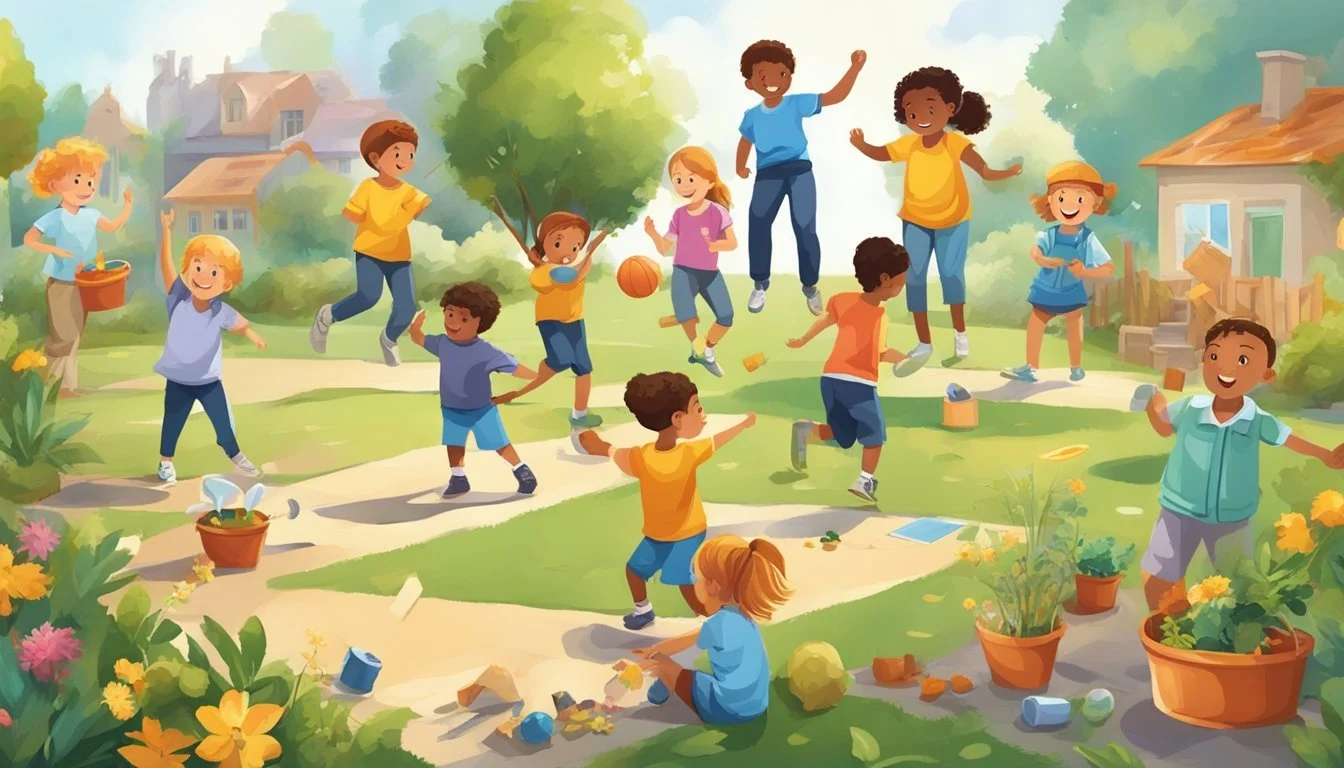6 Strategies for Developing Multiple Intelligences
Enhancing Cognitive Abilities Across Domains
Multiple intelligences theory, proposed by Howard Gardner, suggests that human cognitive abilities extend beyond traditional notions of IQ. This concept recognizes diverse forms of intelligence, including linguistic, logical-mathematical, spatial, musical, bodily-kinesthetic, interpersonal, intrapersonal, and naturalistic abilities.
Developing multiple intelligences can enhance learning and personal growth across various domains. By employing targeted strategies, individuals can strengthen their cognitive capabilities and expand their skill sets. This approach allows for a more holistic view of human potential and offers practical ways to nurture different types of intelligence in educational and personal settings.
1) CreateEngagingLessonPlans
Engaging lesson plans are essential for developing multiple intelligences in the classroom. Teachers can incorporate various activities that cater to different learning styles and abilities.
Visual learners benefit from charts, diagrams, and colorful presentations. Providing visual aids helps reinforce concepts and improves retention.
Auditory learners thrive with discussions, debates, and oral presentations. Including these elements allows students to process information through listening and speaking.
Kinesthetic learners excel with hands-on activities and experiments. Incorporating physical movement and tactile experiences enhances their understanding.
Integrating music, rhythm, and patterns appeals to musical intelligence. Using songs or creating jingles can make learning more enjoyable and memorable.
Group projects and collaborative tasks nurture interpersonal intelligence. These activities foster teamwork and communication skills.
Reflective exercises and journaling support intrapersonal intelligence. Encouraging self-reflection helps students develop self-awareness and critical thinking.
Nature-based activities and outdoor learning experiences cater to naturalistic intelligence. Connecting lessons to the environment promotes a deeper understanding of the natural world.
By designing lessons that encompass these diverse approaches, teachers can effectively engage students with different intelligence profiles and create a more inclusive learning environment.
2) IncorporateHands-OnActivities
Hands-on activities engage multiple intelligences simultaneously, making them valuable tools for teachers. These activities allow students to physically interact with concepts, enhancing their understanding and retention.
For bodily-kinesthetic learners, experiments and building projects provide opportunities to move and manipulate objects. Visual-spatial learners benefit from creating models or diagrams that represent abstract ideas.
Naturalistic intelligence can be developed through activities like planting gardens or observing wildlife. Logical-mathematical thinkers thrive on puzzle-solving and strategy games that require analytical skills.
Musical intelligence can be nurtured through rhythm-based activities or composing simple tunes related to lesson content. Interpersonal skills are honed through group projects and collaborative problem-solving tasks.
Teachers can implement hands-on activities across various subjects. In science, students might conduct experiments. History classes could involve reenactments or artifact creation. Math lessons can incorporate manipulatives for tangible problem-solving experiences.
By incorporating diverse hands-on activities, educators cater to different learning styles and intelligences. This approach helps students connect with the material on multiple levels, leading to deeper comprehension and more engaging classroom experiences.
3) FosterCollaborativeLearning
Collaborative learning encourages students to work together, leveraging their diverse intelligences. Group projects allow individuals to contribute their unique strengths, enhancing overall outcomes.
Teachers can design tasks that require multiple intelligences, such as creating a multimedia presentation on an environmental issue. This engages visual-spatial, linguistic, and naturalistic intelligences simultaneously.
Peer tutoring is another effective strategy. Students with strong logical-mathematical skills can help classmates with math problems, while those with high interpersonal intelligence can facilitate group discussions.
Role-playing exercises tap into bodily-kinesthetic and interpersonal intelligences. Students can act out historical events or scientific processes, deepening their understanding through physical and social engagement.
Collaborative problem-solving activities challenge students to combine their diverse abilities. For example, designing and building a model bridge involves spatial, logical, and hands-on skills.
Music-based group activities, like composing a song about a lesson topic, integrate musical and linguistic intelligences while promoting teamwork. These collaborative approaches foster a rich learning environment that values and develops multiple intelligences.
4) UseTechnologyEffectively
Technology offers powerful tools to engage multiple intelligences in the classroom. Interactive software can target specific intelligences through tailored activities and games.
Visual learners benefit from multimedia presentations and educational videos. Audio recordings and podcasts cater to auditory learners and musical intelligence.
For kinesthetic learners, motion-based games and virtual reality experiences provide hands-on engagement. Logical-mathematical intelligence is enhanced through coding exercises and problem-solving apps.
Social media and online collaboration platforms support interpersonal intelligence development. Journaling apps and self-reflection tools nurture intrapersonal intelligence.
Nature-themed apps and digital field guides appeal to naturalistic intelligence. Language learning software strengthens linguistic intelligence across multiple languages.
Teachers should carefully select age-appropriate technologies that align with curriculum goals. Regular assessment helps ensure technology use remains effective and purposeful.
5) IntegrateArtsInEducation
Integrating arts into education is a powerful strategy for developing multiple intelligences. This approach incorporates visual, musical, and kinesthetic elements into various subjects, engaging students across different learning modalities.
Teachers can use painting, drawing, or sculpture to enhance visual-spatial intelligence in subjects like history or science. Students might create artwork depicting historical events or scientific concepts, deepening their understanding through visual representation.
Music integration supports musical intelligence while reinforcing other areas of learning. For example, using songs to teach mathematical concepts or language patterns can make these topics more accessible and memorable for students.
Drama and role-playing activities tap into bodily-kinesthetic and interpersonal intelligences. These techniques can be applied in literature classes to bring characters to life or in social studies to reenact historical scenarios.
Dance and movement can be incorporated into physical education, science, or even mathematics lessons. This approach helps kinesthetic learners grasp concepts through physical embodiment.
By integrating arts across the curriculum, educators create a rich, multisensory learning environment. This approach not only develops multiple intelligences but also makes learning more engaging and inclusive for diverse student populations.
6) EncouragePhysicalMovement
Physical movement plays a crucial role in developing bodily-kinesthetic intelligence. Teachers can incorporate movement-based activities into their lessons to engage students who excel in this area.
Simple strategies include allowing students to stand or move around while working on tasks. This can help improve focus and concentration for some learners.
Incorporating dance or drama into lessons can be an effective way to teach concepts across various subjects. For example, students might act out historical events or use interpretive dance to represent scientific processes.
Physical games and sports can also be used to reinforce learning. Math concepts can be taught through active games involving counting or measuring distances.
Hands-on activities and manipulatives provide opportunities for tactile learning. Building models, conducting experiments, or creating art projects all engage bodily-kinesthetic intelligence.
Teachers can design lessons that involve mime or gestures to help students remember vocabulary or important concepts. This technique can be particularly useful in language classes.
By incorporating these movement-based strategies, educators can cater to students with strong bodily-kinesthetic intelligence while also providing variety and engagement for all learners.
Understanding Multiple Intelligences
Multiple intelligences theory expands the concept of human cognitive abilities beyond traditional IQ measures. It recognizes diverse ways individuals process information and demonstrate intellectual capability.
The Theory Behind Multiple Intelligences
Howard Gardner introduced the theory of multiple intelligences in 1983. He challenged the notion of a single, fixed intelligence measured by IQ tests. Gardner proposed that people possess various distinct intelligences, each representing different ways of processing information and solving problems.
This theory suggests that intelligence is multifaceted and can be expressed through different modalities. It emphasizes the importance of recognizing and nurturing various strengths in individuals, rather than focusing solely on linguistic and mathematical abilities.
Gardner's approach has influenced educational practices by encouraging diverse teaching methods to cater to different learning styles.
Types of Intelligences
Gardner initially identified seven types of intelligences, later adding an eighth:
Linguistic: Proficiency with words and language
Logical-Mathematical: Skill in reasoning and numerical calculations
Spatial: Ability to visualize and manipulate objects mentally
Musical: Sensitivity to rhythm, pitch, and tone
Bodily-Kinesthetic: Control of body movements and handling objects
Interpersonal: Capacity to understand and interact effectively with others
Intrapersonal: Self-awareness and ability to understand one's own emotions
Naturalistic: Recognition and understanding of natural patterns
Each intelligence type represents a distinct set of skills and abilities. Individuals may excel in one or more areas while having less proficiency in others.
Understanding these intelligences can help educators tailor instruction to students' strengths and provide opportunities for growth across all areas.
Benefits of Developing Multiple Intelligences
Cultivating multiple intelligences offers numerous advantages for personal growth and cognitive development. This approach enhances learning capabilities and prepares individuals for diverse challenges.
Improved Cognitive Skills
Developing multiple intelligences sharpens various cognitive abilities. Linguistic intelligence boosts communication skills, enabling clearer expression of ideas. Logical-mathematical intelligence enhances analytical thinking and problem-solving.
Visual-spatial intelligence improves mental imagery and navigation skills. Musical intelligence refines auditory processing and pattern recognition. Bodily-kinesthetic intelligence enhances physical coordination and dexterity.
Interpersonal intelligence strengthens social skills and empathy. Intrapersonal intelligence deepens self-awareness and emotional regulation. Naturalistic intelligence fosters environmental awareness and classification abilities.
Enhanced Problem-Solving Abilities
Multiple intelligences expand problem-solving capabilities across different domains. Individuals can approach challenges from diverse perspectives, leading to more creative and effective solutions.
For example, combining linguistic and logical-mathematical intelligences allows for clear articulation of complex ideas. Visual-spatial and bodily-kinesthetic intelligences aid in practical, hands-on problem-solving.
Interpersonal and intrapersonal intelligences contribute to resolving social conflicts and personal dilemmas. This multi-faceted approach to problem-solving proves valuable in academic, professional, and personal contexts.
Implementing Strategies in Education
Effective implementation of multiple intelligences strategies in education requires thoughtful planning and execution. Teachers can create environments that engage diverse learning styles and incorporate various intelligences into curriculum design.
Creating a Diverse Learning Environment
Classrooms should offer varied learning stations catering to different intelligences. Visual learners benefit from colorful displays and diagrams. Kinesthetic learners need hands-on materials and movement opportunities.
Provide musical background for some activities to engage auditory learners. Include quiet spaces for intrapersonal reflection. Set up collaborative areas for interpersonal activities.
Rotate seating arrangements regularly to accommodate different learner preferences. Use flexible furniture that can be easily rearranged for various activities and group sizes.
Incorporating Intelligences in Curriculum Design
Develop lesson plans that activate multiple intelligences simultaneously. For a history lesson, students might:
• Create timelines (visual-spatial) • Write and perform skits (verbal-linguistic, bodily-kinesthetic) • Compose period-appropriate music (musical) • Analyze historical figures' motivations (intrapersonal) • Debate in groups (interpersonal) • Calculate relevant statistics (logical-mathematical)
Offer assessment options aligned with different intelligences. A book report could be a written essay, oral presentation, artistic interpretation, or dramatic performance.
Design interdisciplinary units connecting subjects through various intelligences. A rainforest unit might combine science, math, art, and music activities.




